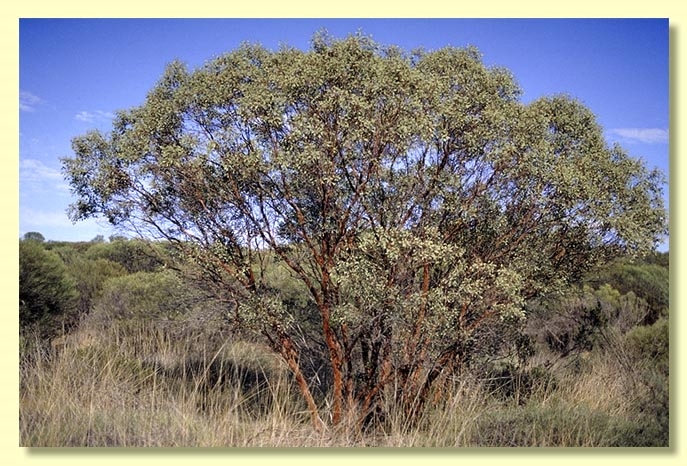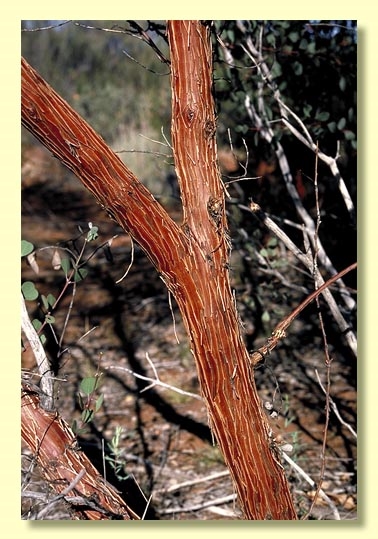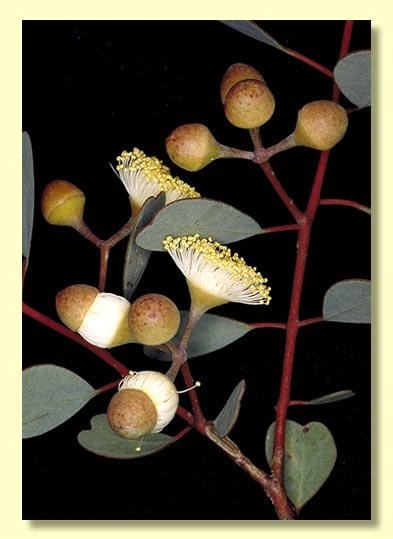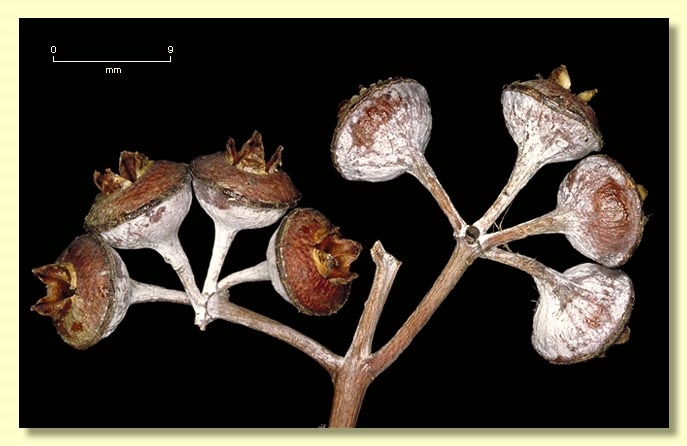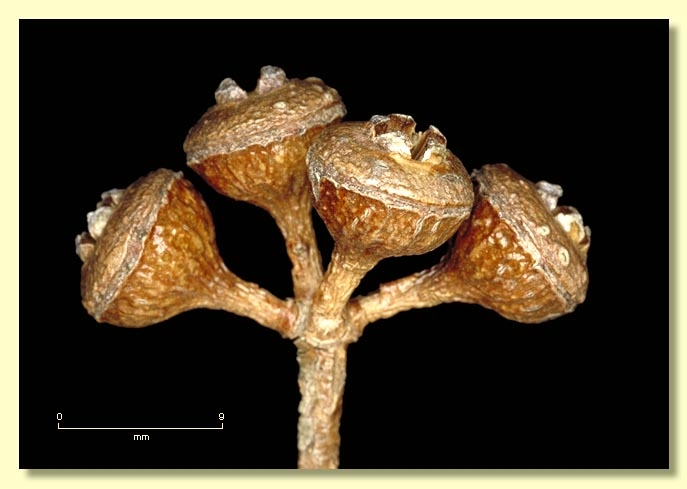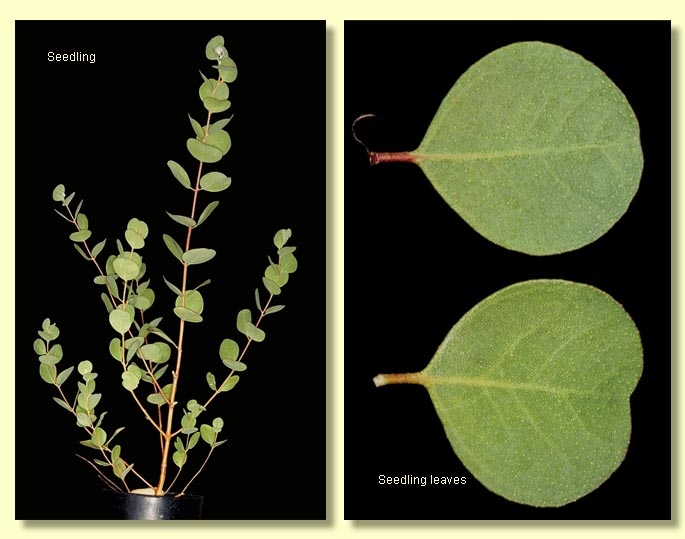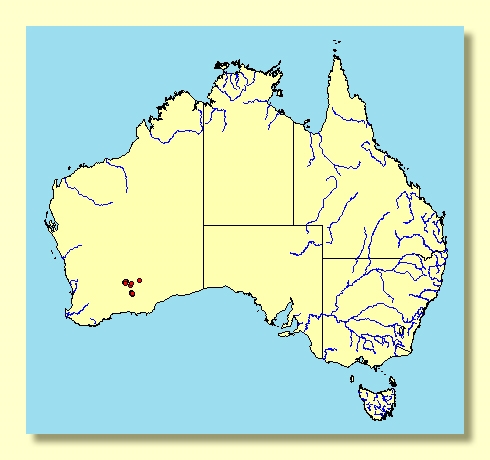Euclid - Online edition
Eucalyptus websteriana
Eucalyptus | Symphyomyrtus | Bisectae | Destitutae | Curviptera | Orbifoliae
T: Coolgardie, W.A., 1900, L.C.Webster ; lecto: NSW (fide L.A.S.Johnson & K.D.Hill Telopea 4: 626 (1992)).
Eucalyptus websteriana Maiden subsp. norsemanica L.A.S.Johnson & K.D.Hill, Telopea 4: 627 (1992). T: Western Australia: 5.5 miles [8.5 km] N of Norseman, 18 Dec. 1960, L.A.S.Johnson W 176; holo NSW; iso: PERTH.
Bark minnirichi on trunk and branches, red to red-brown.
Branchlets sometimes glaucous; lacking oil glands in the pith.
Juvenile growth (coppice or field seedlings to 50 cm): not seen.
Adult leaves usually alternate but sometimes a mixture of sub-opposite and alternate, petioles 0.5–1.7 cm long; blade obovate to obcordate, 1.8–4.5 cm long, 0.9–3 cm wide, base tapering to petiole, margin entire, apex emarginate or rounded, concolorous, grey-green to grey (new growth may be glaucous but expanded leaves not so), side-veins greater than 45° to midrib, reticulation very dense, intramarginal vein remote from margin, oil glands intersectional, star-shaped.
Inflorescence axillary unbranched, peduncles 0.9–1.2 cm long, buds 7, pedicellate, pedicels 0.3–0.7 cm long. Mature buds globular (0.5–1 cm long, 0.5–0.8 cm wide), rarely glaucous, scar present, operculum rounded and apiculate (0.4–0.7 cm long), stamens oblique or obliquely-erect, anthers cuboid, versatile, basifixed, dehiscing by longitudinal slits, style long and straight or bent in the apical third, stigma blunt, locules 4(5), the placentae each with 4 vertical rows of ovules. Flowers cream to pale lemon-yellow.
Fruit pedicellate, pedicels 0.4–0.7 cm long, hemispherical or less commonly broadly obconical, rarely glaucous, 0.3–0.6 cm long, 0.7–1.2 cm wide, disc ascending or more or less flat, valves 4(5), prominently exserted.
Seeds mid-brown, 1–2 mm long, cuboid to angularly ovoid, dorsal surface shallowly reticulate, hilum ventral or terminal.
Cultivated seedlings (measured at node 10): cotyledons Y-shaped (bisected); stems rounded in cross-section, warty, rarely glaucous; leaves opposite and subsessile, linear to oblong for ca 3 nodes, then becoming petiolate, alternate by 7–14 nodes, obovate, obcordate or orbicular, 1.3–4 cm long, 1–3.5 cm wide, base tapering, apex rounded or emarginate, grey-green, lamina surface slightly warty; new growth glaucous but the wax not persisting as leaves expand.
Flowering has been recorded in July, August and September.
A small mallee endemic to Western Australia, found only in the Goldfields area and western fringe of the Great Victoria Desert, from Yeo Lake east of Cosmo Newberry south-west to Karonie, Kambalda and Norseman, on rocky sites. The bark is minnirichi on trunk and branches and crown leaves are grey-green.
Eucalyptus websteriana belongs in Eucalyptus subgenus Symphyomyrtus section Bisectae subsection Destitutae because buds have two opercula, cotyledons are Y-shaped and branchlets lack oil glands in the pith. Within this subsection E. websteriana is in series Curviptera, one of about 30 closely related species and subspecies which are further characterised by having buds in umbels of one, three or seven, staminal filaments erect or oblique (rarely inflexed) in bud, and large fruit usually with an ascending disc and exserted valves.
Within the series Curviptera this species is most closely related to E. crucis, E. ewartiana, E. orbifolia and E. educta which form a subgroup, subseries Orbifoliae. All have minnirichi bark, buds in umbels of three or seven (rarely 11). All have stamens arranged obliquely in bud except E. educta which has erect stamens. All have seeds that are angularly ovoid though scarcely ridged.
E. websteriana, E. orbifolia and E. educta differ from the other species in crown leaves—they are opposite to alternate, petiolate and obovate to obcordate. E. websteriana, with rounded operculum, oblique stamens, straight style and more or less hemispherical fruit, differs from E. educta, which has a long conical operculum, erect stamens, twisted style and obconical fruit. E. orbifolia differs from E. websteriana only in having shallowly obconical fruit and pronounced glaucescence.
Eucalyptus websteriana subsp. norsemanica was described from a population just north of the Goldfields town of Norseman. It differs from the more widespread form of E. websteriana in the lack of visible white wax (i.e. is non-glaucous), sometimes shorter petioles and pedicels, and narrowish leaves, although all the dimensions given in the original description overlap considerably. The subspecies is not recognised in EUCLID.

